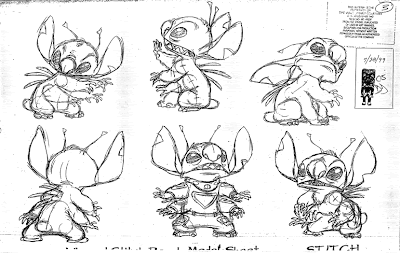
Now that you've familiarized yourself with constructing a form, lets turn these forms into heads. Use the same head for the entire assignment and vary the angles for different expressions. Remember that you are
illustrating an idea, or in this case an expression, so make sure that everything you do is in support of that idea. The
character's behavior in relationship to the idea is more important than having a nice form drawing that expresses nothing about the character. It is recommended that you use a mirror to assist you in executing the assignment. Essentially, we want the
character to act out these emotions as believable as possible while maintaining the
consistency of each drawing. It is to your advantage to create a solid, yet simple, overall form for your character's head instead of something too realistic or complex. Make sure you
start by labeling the corresponding word to your character's expression
before drawing.
In order of importance:
- Idea, story (in this case the word that describes the expression)
- Basic construction (see w1a)
- Secondary forms/masses and their directions subordinating the main idea
- Supporting details such as hair, creases, eyebrows, and accents
- External details like accessories, patterns, textures
**Though hairstyle is an important aspect of a character, for this assignment we will not be concerning with it too much. The reason is sometimes hair can be overwhelming and take over what we are trying to achieve.
DO: Create orthographic views for your character's head (front, side, back). Then, do a drawing for each of the facial expression listed below. Obviously there more than one way to describe these expressions, some will have more room for variations, while others will be limited.
happy, satisfied, coy, shy
aloof, confident, ecstatic, goofy
sad, worried, nervous, confused,
tired, exhausted, dizzy, knocked-out
annoyed, mad, angry, frightened
surprised, contempt, ashamed
awe, skeptical, bored, disgusted
wink, smile, laugh, cry, yell
thinking, scheming, focusing









 Now that you've familiarized yourself with constructing a form, lets turn these forms into heads. Use the same head for the entire assignment and vary the angles for different expressions. Remember that you are illustrating an idea, or in this case an expression, so make sure that everything you do is in support of that idea. The character's behavior in relationship to the idea is more important than having a nice form drawing that expresses nothing about the character. It is recommended that you use a mirror to assist you in executing the assignment. Essentially, we want the character to act out these emotions as believable as possible while maintaining the consistency of each drawing. It is to your advantage to create a solid, yet simple, overall form for your character's head instead of something too realistic or complex. Make sure you start by labeling the corresponding word to your character's expression before drawing.
Now that you've familiarized yourself with constructing a form, lets turn these forms into heads. Use the same head for the entire assignment and vary the angles for different expressions. Remember that you are illustrating an idea, or in this case an expression, so make sure that everything you do is in support of that idea. The character's behavior in relationship to the idea is more important than having a nice form drawing that expresses nothing about the character. It is recommended that you use a mirror to assist you in executing the assignment. Essentially, we want the character to act out these emotions as believable as possible while maintaining the consistency of each drawing. It is to your advantage to create a solid, yet simple, overall form for your character's head instead of something too realistic or complex. Make sure you start by labeling the corresponding word to your character's expression before drawing.